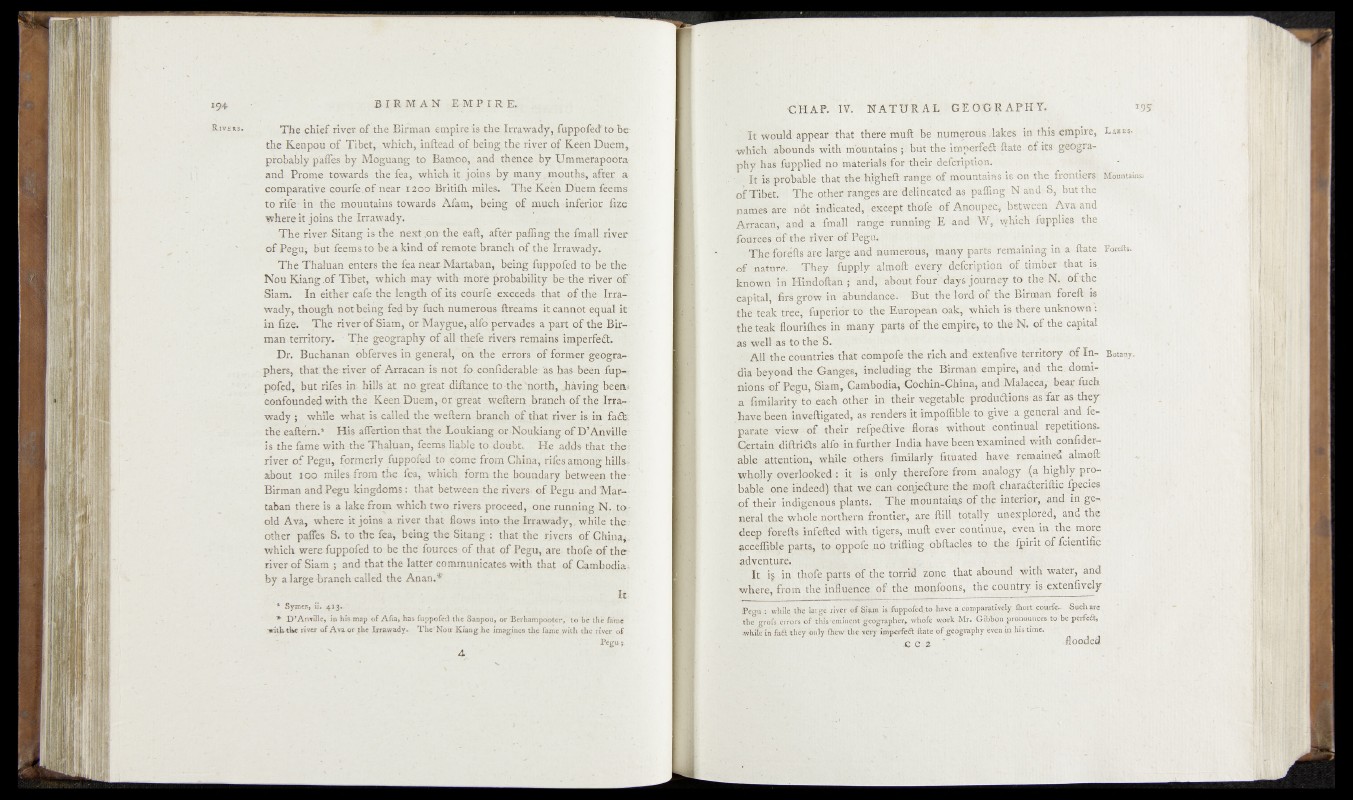
B IR M AN IM P r R E,
The chief river of the Birman empire is the Irrawady, fuppofecTto be
the Kenpou of Tibet, which, inftead of being, the river of Keen Duem,
probably pafles by Moguang to Baipaop» and thence by Ummerapoora
and JProroe towards the Tea, which.it joips by many „mouths, after a
comparative courfc.of near 1200 Britifh miles. The Keen D'uem feems.
to: rife-in- the mountains towards Afam, being of much rinferior, fize
where it joins, the Irrawady.
The river Sitang is the next .on the eaft, after palling the fmall. river
of Pegu, but feems to be a kind of remote branch of the Irrawady. •
The Thaluan enters the Tea near.Martaban, being fuppofed w b e the-
Nou Kiang .of Tibet, which may with more probability be-the ri-yer 'off
Siam. In either cafe the length of its eourfe exceeds that of the Irrawady,
though not being fc^ by fuch numerous ftreams it ,cannot equal it
in fize. The river of Siam, or Maygue,-alfq pervades a part of the Birman,
territory. - The geography of all thefe rivers remains imp'erfedt.
Dr. Buchanan obferves in general, on the errors' of former gebgra--
phers, that the river of Arracan is not. fo eonfiderabie 4$ has been Tup-»,
pofed, but rifes in hillsht no great jdiftance, to -theTtPtth, ^yini; been*
unfounded with the Keen Duem,-or ■ p’ea^ vyefterit hrapphpf thelrra*-
wady ; while what is called the weftern branch of that river is in fa£k
die eafterh.* His aflertipn that the Loukiang or-Npukiang of
is the fame with the Thaluan, fcems liable to doubt. H>e adds that the
.river, of Pegu, formerly fuppofed to come from China, rifcs.atnoug hills -
about 100 miles from the fea, which form the boundary between the •
Birman and Pegu kingdoms : that between the rivers- of Pegu* and Martaban
there is a lake from which two riv-ers proceed, one running N. to-
old Ava, where it joins a river that flows into the lrrawady,, while the:
other pafles S. to-the fea-, being the Sitang.: that the rivers of Ghina^.
which were fuppofed to be the fources of that of Pegu, are- thpfe of the
river of Siam $ and that the latter communicates with- that of Cambodia-,
by a.large -braneh called the Anan.*
It
* Symes, ii. 413-"
* D ’Anville, in his map o f Afia, has fuppofed .the Sanpou, or Berhampootery to be the fame
witiuhe river of Ava.or Jthe Irrawady. The'Notr Kiang .he imagines the fame .with the river of
G^HAP. IV. NATURAL GEOGRAPHY.
It would appear -that there muft be numerous .lakes in this empire, Lares.
which abounds with mountains ; but the imperfe£t ftate of its g^Ography
has fiapplied no materiateTor theh»''defcription. . tj g ' :
■ it is probable that the htgheft range of mountains is on the frontiers Mountains.-
of Tibet. The other ranges are delineated as paffing N and S, but the
names are nöt indicated, .except th'ofe of Anoupee, between Ava and
Arracan,'and a fmall range' running E and W, which fupplies the
fources of the river of Peg«:, $ ' . dj ' . . .
The forefts are large and numerous, many parts remaining in a Bate Forefts.
of nature. They fupply almoft every 'defcripition of timber that is
known in Hindoftan j and,f>bhu€ fouri'dayS journey 60 the- Ni- ‘ófshe
^apltaly-^irs grow in 'abuffdao.ee. ©ut the -lord- éfHhe Birman foreft is
the teak tree, fuperidr to the .European oak, which is there unknown :
the teak flouriflxes in many parts of thé empire, to thè'N. of the capital
as .welf as to the S. |
1 AiP-the countries that compofe the rich and ex-tenfive territory óf-In- Botany,
dk beyond the Ganges, includijig the Birman empire, and the dominions
©f Pegu, Siam, Cambodia, ■ Gochin->China, and ^Malacca, bear fuch
a fimilarity'to each other in their vegetable prodiidions'as'Tar as they
have been inveftigated, as cenders fo impofflbfe to give a general and Te- '
parate view of their refpe&ive florae without continual repetitions.
Certain diftri&s alfo in further India have heen examined with conftder-
able attention,. while others Jteilariy fituated have remained sftmoft
wholly overlooked J it > .only thefefqpeTfem^ana^gy »(a bigjfty/pro-
bakp one indeed) that we can pory-edture the mpft ebarafteriftic fp^ejes
-of their indigenous plants, The mou .utaiuSt thp interior, and in geppral
the tvhnle.n^rthem frqotïèX, are ft ill; n egtpp r e d, and fhe
deep forefts infefted with tigers, muft; pv^ricqutintje., even in t the more
accefftble parts, to qppofe .up trifling -qhftacles to thp jl^hit qf feientifiq
adventure, ,, n- 1 -r: , / ■.. - y n . . ■
It ig in thofe pacts of the toryujl zone that abound 'v^ith water, and
where, from the jkikenefe.'of the meqfoQns, the country is p^tehfivejy
aPega : while the laige river ef-Sjtim is *Epofeclto -have a comparatively %olt.cp|irie^ Such are
_ the grofs errors of this-emineht'geog>^er’ whóri Wori^Mr. Gibbon^rdnomices to be perfcö,
.whiit in fa6t they only ihew the very imperfeft ftate of geography even in his'time.
‘ vC C 2 .flooded